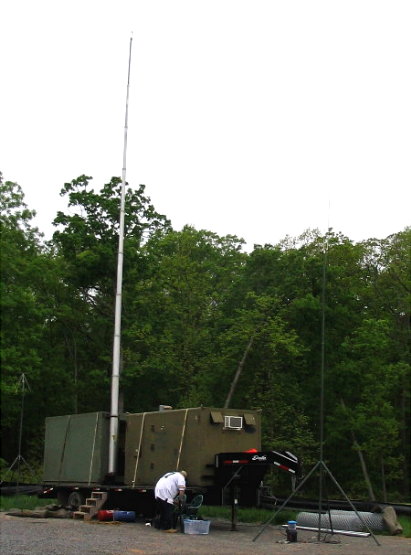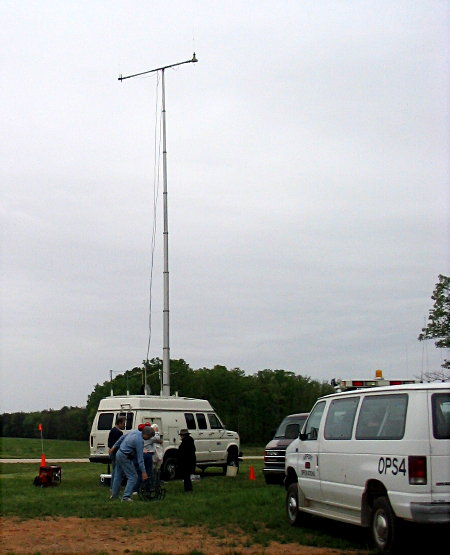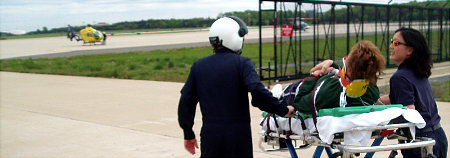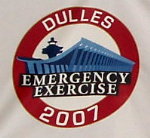|

The incident scenario was a taxiway collision between an Airbus A-320
and two buses
carrying construction workers on a very foggy morning
|
This is the second periodic emergency exercise since 9-11 at Dulles International Airport that amateur radio operators participated in as members of the Amateur Radio Emergency Service (ARES). Unlike the 9-11 Operation but like the 2004 emergency exercise, planning and preparation were begun earlier in the year. Tom Dawson, WB3AKD of Round Hill, the Emergency Coordinator for Loudoun County Amateur Radio Emergency Service, coordinated planning and participation by Loudoun, Fairfax, Prince William, Arlington, Alexandria, Fall Church City, and other Northern Virginia elements of ARES.
David Lane, KG4GIY of Manassas, coordinated the ARES operation in the Dulles Airport EOC and the operations at Prince William Hospital.
Tom Azlin, N4ZPT of Vienna, coordinated the mobile Automatic Position Reporting System (APRS), and hospital bus communications.
Jeff Wilson, AI4IO of Springfield, coordinates staffing and operations for Fairfax Hospitals.
Bill Frisbie, W3EMH of Sterling, an Assistant Emergency Coordinator for Loudoun County ARES, coordinates staffing and operations for Loudoun Hospitals.
Larry Hughes, K3HE of Leesburg, was the Loudoun Red Cross/Family Assistance Liaison.
Tom Dawson was also assisted by Gary Quinn - NC4S of Lovettsville, an Assistant Emergency Coordinator for Loudoun County ARES.
An 'All Hands' coordination meeting was held at the Cascades Library in eastern Loudoun County on Monday, April 30, 2007. A preliminary site access and duty roster was prepared at this meeting and distributed by Gary Quinn - NC4S. An Operations Plan for the Dulles Emergency Exercise and an Operations Plan for the Hospital Bus Communications were published on May 4, 2007. Seventy-four volunteers appeared on the pre-exercise roster.
Sixty-two amateur radio operators actually participated in this event. See actual operational roster here. Thirty-nine actually manned positions on the Dulles Airport grounds while another twenty-three actually operated off site providing mobile APRS and on-board communications to the bus evacuation of accident victims or at liaison communications stations in the local hospitals.
Two mobile communications assets were pre-positions near the crash site and provided facilities for the net controls and the APRS central monitoring stations.
|

Dual Mobile Comm Shelters
Provided By Tom Dawson - WB3AKD of Round Hill
|

The AMRAD Comm Van
Provided By Frank Gentges - KØBRA of Great Falls |
This was a big communications operation with several interdependent voice, automatic data, and video communications systems that came together in the net control center shelters deployed by Tom Dawson and Frank Gentges and manned by a dozen ARES operators. These mobile shelters were deployed near the incident site. The Dulles Airport EOC, the Helo Landing Zone, the six patient evacuee buses, the six hospital centers, the assemble area, and the several key Dulles Airport operational personnel 'shadow radio operators' were tied together. An Amateur Television link and other data links were also tested.
|
Tom Dawson published the following thank you message on the Loudoun ARES and the Loudoun Amateur Radio Group's 'QST de K4LRG' Reflectors on May 6, 2007:
|
| |
"Thankfully, another IAD Drill is behind us. From personal contact with MWAA staff, I can say that they are very happy with the Ham Radio support they
received, and we can all be happy with that.
There will, no doubt, be comments and observations from the participants and observers, and there will be an after-action meeting for the planners later this month.
Our own analysis of our operations will be as follows:
Participants from each county should forward their comments to their respective EC's, EC's should collect and summarize, and combine those comments where appropriate and forward them to me. There will be a leadership meeting within the next couple of weeks to review the comments and formulate recommendations for future operations.
EC's, please identify any specific individuals that went above and beyond normal duties to facilitate the drill as I would like to hold an after-action all-hands meeting to review the comments and recommendations and recognize superior performance.
Thanks to all who participated and special thanks to EC's, AEC's, Hospital Leads, and APRS Leads for outstanding performance in bringing together the people and technology in what is always a challenging operation."
73, Tom Dawson - WB3AKD
ARES EC Loudoun County, VA
(540) 454-0520 (Cell)
(877) 790-3115 (Pager)
[email protected]
|
|
|
There are many stories to tell. A few will appear here: |
The Loudoun - Cornwall Hospital Story
Bill McCourt - WF1L, Jay Ives - KI4TXP, and Chuck Graham - KI4IEO deployed to the Loudoun Hospital in Leesburg.
Here is their story
|

Jay Ives - KI4TXP at Loudoun - Cornwall Hospital
|
|

Patient Hand-Off At Helo Med Evac Landing Zone
|
Helo Med Evac Operation Story
Norm Styer - AI2C and Karl Hamilton - KI4BDS
were assigned to the Helo Med Evac Landing Zone.
Here is their story
|
Many of us have deployed like this before but we almost always learn something new each time. Again, we must remind ourselves that the real ones aren't planned and time is more than of the essence when they occur. Please, do not unpack your go-bag, rigs and gear; just reload, recharge your batteries, and stand by for that unannounced call to duty.
If you missed this or didn't see it all while deployed then try to attend the after action and evaluation meetings that will be conducted.
|

By 1200 hours, the crash site is clear, all air and ground evacuated patients were returning from their hospital visits
and many ARES operators were released from their assignments. The ARES nets closed stations over the next several hours.
If you have a story to tell then pass it along and I'll upload it here to K4LRG.ORG. As always, it was nice riding with you all. Best Regards, Norm Styer - AI2C de Clarkes Gap, Virginia |
|
NNNN
|






